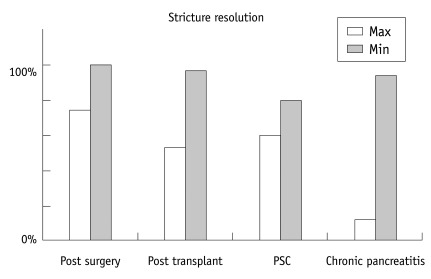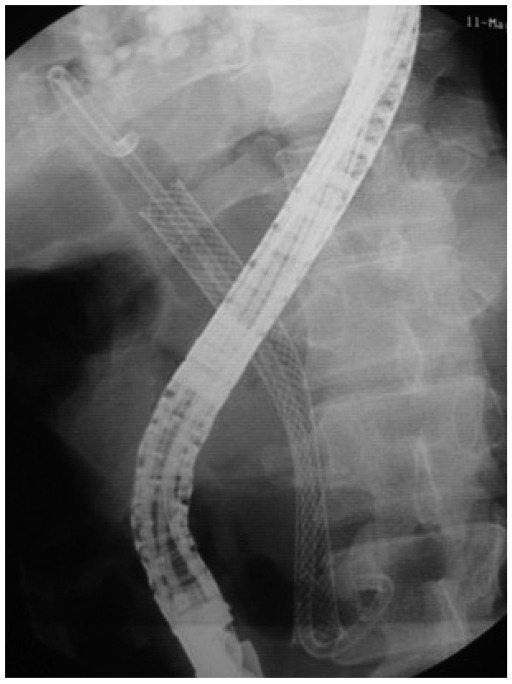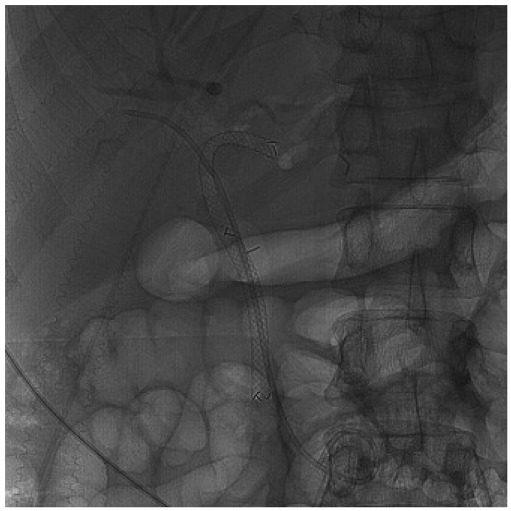Korean J Radiol.
2012 Feb;13(Suppl 1):S67-S73. 10.3348/kjr.2012.13.S1.S67.
Role of Fully Covered Self-Expandable Metal Stent for Treatment of Benign Biliary Strictures and Bile Leaks
- Affiliations
-
- 1Division of Gastroenterology, Department of Medicine, Siriraj Hospital, Mahidol University, Bangkok 10700, Thailand.
- 2Division of Gastroenterology, Department of Medicine, Chulalongkorn University, Bangkok 10330, Thailand. Rungsun@pol.net
- KMID: 1372870
- DOI: http://doi.org/10.3348/kjr.2012.13.S1.S67
Abstract
- Endoscopic therapy by balloon dilation and placement of multiple large-bore plastic stents is the treatment of choice for benign biliary stricture. This approach is effective but it typically requires multiple endoscopic sessions given the short duration of stent patency. The endoscopic approach for treatment of bile leak involves the placement of a stent with or without biliary sphincterotomy. The self-expandable metal stent (SEMS) has traditionally been used for palliation of malignant biliary strictures given the long duration of stent patency owing to their larger stent diameter. Recently, SEMS has been used in a variety of benign biliary strictures and leaks, especially with the design of the covered self-expandable metal stent (CSEMS), which permits endoscopic-mediated stent removal. The use of CSEMS in benign biliary stricture could potentially result in a decrease in endoscopic sessions and it is technically easier when compared to placement of multiple plastic stents. However, complications such as cholecystitis due to blockage of cystic duct, stent migration, infection and pancreatitis have been reported. The potential subsegmental occlusion of contralateral intrahepatic ducts also limits the use of CSEMS in hilar stricture. Certain techniques and improvement of stent design may overcome these challenges in the future. Thus, CSEMS may be appropriate in only highly selected conditions, such as refractory benign biliary stricture, despite multiple plastic stent placement or difficult to treat bile duct stricture from chronic pancreatitis, and should not be used routinely. This review focuses on the use of fully covered self-expandable metal stent for benign biliary strictures and bile leaks.
Keyword
MeSH Terms
Figure
Cited by 1 articles
-
Current Status of Biliary Metal Stents
Hyeong Seok Nam, Dae Hwan Kang
Clin Endosc. 2016;49(2):124-130. doi: 10.5946/ce.2016.023.
Reference
-
1. Perri V, Familiari P, Tringali A, Boskoski I, Costamagna G. Plastic biliary stents for benign biliary diseases. Gastrointest Endosc Clin N Am. 2011; 21:405–433. viiiPMID: 21684462.
Article2. Bakhru MR, Kahaleh M. Expandable metal stents for benign biliary disease. Gastrointest Endosc Clin N Am. 2011; 21:447–462. viiiPMID: 21684464.
Article3. Kuo MD, Lopresti DC, Gover DD, Hall LD, Ferrara SL. Intentional retrieval of viabil stent-grafts from the biliary system. J Vasc Interv Radiol. 2006; 17:389–397. PMID: 16517789.
Article4. Cahen DL, van Berkel AM, Oskam D, Rauws EA, Weverling GJ, Huibregtse K, et al. Long-term results of endoscopic drainage of common bile duct strictures in chronic pancreatitis. Eur J Gastroenterol Hepatol. 2005; 17:103–108. PMID: 15647649.
Article5. Traina M, Tarantino I, Barresi L, Volpes R, Gruttadauria S, Petridis I, et al. Efficacy and safety of fully covered self-expandable metallic stents in biliary complications after liver transplantation: a preliminary study. Liver Transpl. 2009; 15:1493–1498. PMID: 19877248.
Article6. Mahajan A, Ho H, Sauer B, Phillips MS, Shami VM, Ellen K, et al. Temporary placement of fully covered self-expandable metal stents in benign biliary strictures: midterm evaluation (with video). Gastrointest Endosc. 2009; 70:303–309. PMID: 19523620.
Article7. Park do H, Lee SS, Lee TH, Ryu CH, Kim HJ, Seo DW, et al. Anchoring flap versus flared end, fully covered self-expandable metal stents to prevent migration in patients with benign biliary strictures: a multicenter, prospective, comparative pilot study (with videos). Gastrointest Endosc. 2011; 73:64–70. PMID: 21184871.
Article8. Hu B, Gao DJ, Yu FH, Wang TT, Pan YM, Yang XM. Endoscopic stenting for post-transplant biliary stricture: usefulness of a novel removable covered metal stent. J Hepatobiliary Pancreat Sci. 2011; 18:640–645. PMID: 21643818.
Article9. Hall JG, Pappas TN. Current management of biliary strictures. J Gastrointest Surg. 2004; 8:1098–1110. PMID: 15585398.
Article10. Shanbhogue AK, Tirumani SH, Prasad SR, Fasih N, McInnes M. Benign biliary strictures: a current comprehensive clinical and imaging review. AJR Am J Roentgenol. 2011; 197:W295–W306. PMID: 21785056.
Article11. Larghi A, Tringali A, Lecca PG, Giordano M, Costamagna G. Management of hilar biliary strictures. Am J Gastroenterol. 2008; 103:458–473. PMID: 18028506.
Article12. Kaffes AJ, Hourigan L, De Luca N, Byth K, Williams SJ, Bourke MJ. Impact of endoscopic intervention in 100 patients with suspected postcholecystectomy bile leak. Gastrointest Endosc. 2005; 61:269–275. PMID: 15729238.
Article13. Kahaleh M, Behm B, Clarke BW, Brock A, Shami VM, De La Rue SA, et al. Temporary placement of covered self-expandable metal stents in benign biliary strictures: a new paradigm? (with video). Gastrointest Endosc. 2008; 67:446–454. PMID: 18294506.
Article14. Chaput U, Scatton O, Bichard P, Ponchon T, Chryssostalis A, Gaudric M, et al. Temporary placement of partially covered self-expandable metal stents for anastomotic biliary strictures after liver transplantation: a prospective, multicenter study. Gastrointest Endosc. 2010; 72:1167–1174. PMID: 20970790.
Article15. Sauer BG, Regan KA, Srinivasan I, Shami VM, Rehan ME, Ellen K, et al. Temporary placement of covered self-expandable metal stents (CSEMS) in benign biliary strictures (BBS): eight years of experience. Gastrointest Endosc. 2010; 71:AB110–AB111.16. Brijbassie A, Stevens PD, Sethi A, Sejpal DV, Raijman I, Loren DE, et al. Use of fully covered self expanding metal stents (FCSEMS) in the management of benign biliary diseases (BBD). Gastrointest Endosc. 2010; 71:AB298.17. Pascher A, Neuhaus P. Bile duct complications after liver transplantation. Transpl Int. 2005; 18:627–642. PMID: 15910286.
Article18. Bismuth H. Blumgart LH, editor. Postoperative stricture of the bile duct. The biliary tract. 1982. Edinburgh: Churchill Livingstone;p. 209–218.19. Strasberg SM, Hertl M, Soper NJ. An analysis of the problem of biliary injury during laparoscopic cholecystectomy. J Am Coll Surg. 1995; 180:101–125. PMID: 8000648.20. Draganov P, Hoffman B, Marsh W, Cotton P, Cunningham J. Long-term outcome in patients with benign biliary strictures treated endoscopically with multiple stents. Gastrointest Endosc. 2002; 55:680–686. PMID: 11979250.
Article21. Vandenbroucke F, Plasse M, Dagenais M, Lapointe R, Lêtourneau R, Roy A. Treatment of post liver transplantation bile duct stricture with self-expandable metallic stent. HPB (Oxford). 2006; 8:202–205. PMID: 18333277.
Article22. Tee HP, James MW, Kaffes AJ. Placement of removable metal biliary stent in post-orthotopic liver transplantation anastomotic stricture. World J Gastroenterol. 2010; 16:3597–3600. PMID: 20653071.
Article23. Cantù P, Hookey LC, Morales A, Le Moine O, Devière J. The treatment of patients with symptomatic common bile duct stenosis secondary to chronic pancreatitis using partially covered metal stents: a pilot study. Endoscopy. 2005; 37:735–739. PMID: 16032492.
Article24. Behm B, Brock A, Clarke BW, Ellen K, Northup PG, Dumonceau JM, et al. Partially covered self-expandable metallic stents for benign biliary strictures due to chronic pancreatitis. Endoscopy. 2009; 41:547–551. PMID: 19533560.
Article25. García-Pajares F, Sánchez-Antolín G, Pelayo SL, Gómez de la Cuesta S, Herranz Bachiller MT, Pérez-Miranda M, et al. Covered metal stents for the treatment of biliary complications after orthotopic liver transplantation. Transplant Proc. 2010; 42:2966–2969. PMID: 20970584.
Article26. Cahen DL, Rauws EA, Gouma DJ, Fockens P, Bruno MJ. Removable fully covered self-expandable metal stents in the treatment of common bile duct strictures due to chronic pancreatitis: a case series. Endoscopy. 2008; 40:697–700. PMID: 18704837.
Article27. van Boeckel PG, Vleggaar FP, Siersema PD. Plastic or metal stents for benign extrahepatic biliary strictures: a systematic review. BMC Gastroenterol. 2009; 9:96. PMID: 20017920.
Article28. Tringali A, Familiari P, Mutignani M, Perri V, Costamagna G. Self-expandable, removable, fully covered metal stents to dilate common bile duct strictures secondary to chronic pancreatitis: preliminary results. Gastrointest Endosc. 2010; 71:AB169–AB170.29. Hwang JC, Kim JH, Yoo BM, Lim SG, Kim JH, Kim WH, et al. Temporary placement of a newly designed, fully covered, self-expandable metal stent for refractory bile leaks. Gut Liver. 2011; 5:96–99. PMID: 21461081.
Article30. Coté GA, Kumar N, Ansstas M, Edmundowicz SA, Jonnalagadda S, Mullady DK, et al. Risk of post-ERCP pancreatitis with placement of self-expandable metallic stents. Gastrointest Endosc. 2010; 72:748–754. PMID: 20630513.
Article31. Ho H, Mahajan A, Gosain S, Jain A, Brock A, Rehan ME, et al. Management of complications associated with partially covered biliary metal stents. Dig Dis Sci. 2010; 55:516–522. PMID: 19267200.
Article32. Bezzi M, Zolovkins A, Cantisani V, Salvatori FM, Rossi M, Fanelli F, et al. New ePTFE/FEP-covered stent in the palliative treatment of malignant biliary obstruction. J Vasc Interv Radiol. 2002; 13:581–589. PMID: 12050298.
Article33. Hausegger KA, Thurnher S, Bodendörfer G, Zollikofer CL, Uggowitzer M, Kugler C, et al. Treatment of malignant biliary obstruction with polyurethane-covered Wallstents. AJR Am J Roentgenol. 1998; 170:403–408. PMID: 9456954.
Article34. Ridtitid W, Rerknimitr R, Amornsawadwattana S, Ponauthai Y, Kullavanijaya P. Stent-in-stent through a side hole to prevent biliary metallicstent migration. World J Gastrointest Endosc. 2011; 3:64–66. PMID: 21455345.
Article35. Poley JW, van Tilburg AJ, Kuipers EJ, Bruno MJ. Breaking the barrier: using extractable fully covered metal stents to treat benign biliary hilar strictures. Gastrointest Endosc. 2011; 74:916–920. PMID: 21821252.
Article36. Ridtitid W, Rerknimitr R, Janchai A, Kongkam P, Treeprasertsuk S, Kullavanijaya P. Reply to Dr. Viroj Wiwanikit. Surg Endosc. 2011; [Epub ahead of print].
Article
- Full Text Links
- Actions
-
Cited
- CITED
-
- Close
- Share
- Similar articles
-
- Temporary Placement of a Newly Designed, Fully Covered, Self-Expandable Metal Stent for Refractory Bile Leaks
- Refractory benign biliary stricture due to chronic pancreatitis in two patients treated using endoscopic ultrasound-guided choledochoduodenostomy fistula creation: case reports
- The Efficacy and Safety of Fully Covered Self-expandable Metal Stents in Benign Extrahepatic Biliary Strictures
- Current Status of Biliary Metal Stents
- Fully Covered Self Expandable Metal Stent for the Treatment of Benign Biliary Strictures




